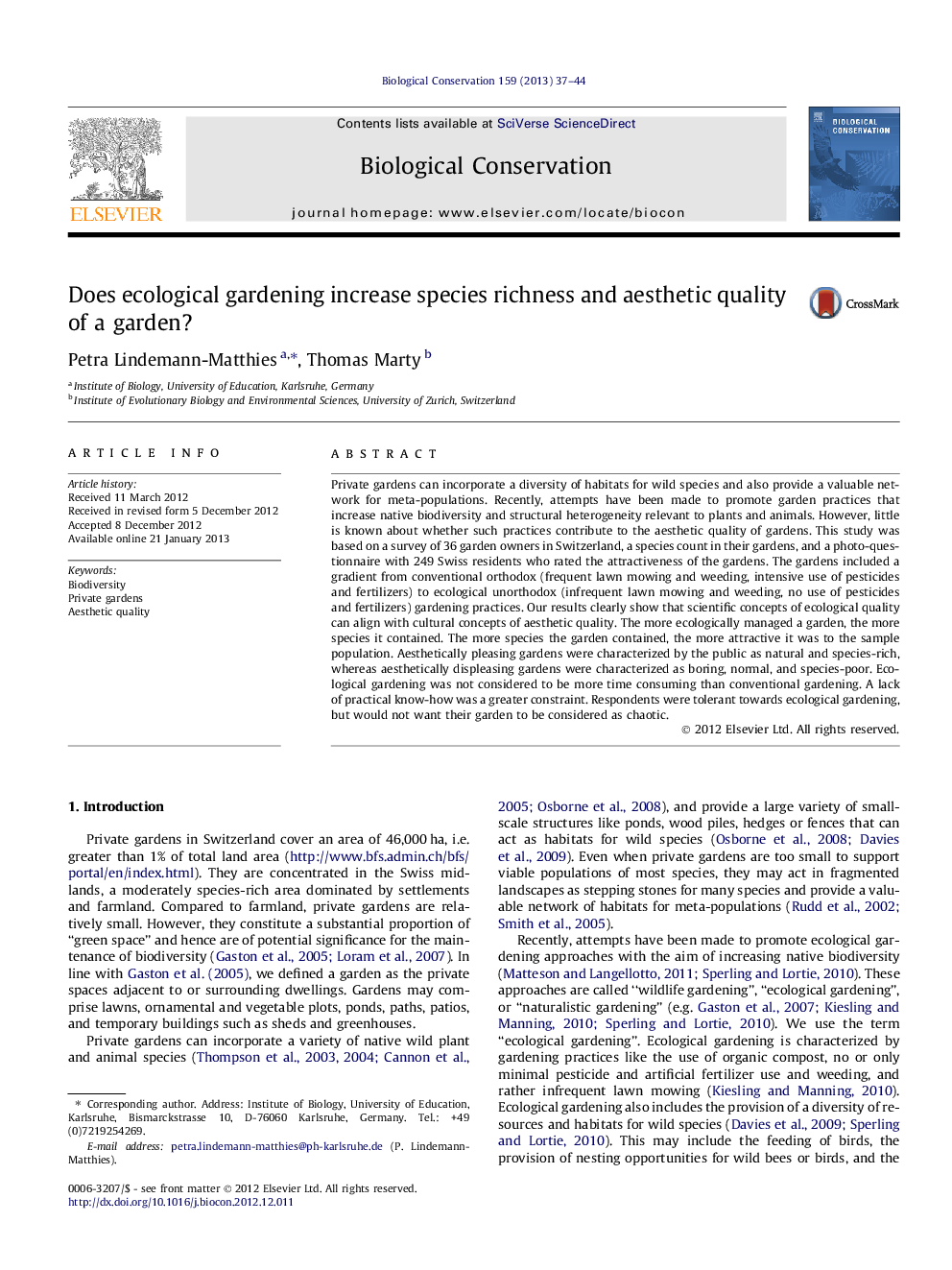| کد مقاله | کد نشریه | سال انتشار | مقاله انگلیسی | نسخه تمام متن |
|---|---|---|---|---|
| 6300930 | 1617942 | 2013 | 8 صفحه PDF | دانلود رایگان |
عنوان انگلیسی مقاله ISI
Does ecological gardening increase species richness and aesthetic quality of a garden?
ترجمه فارسی عنوان
آیا باغبانی زیست محیطی غنی بودن گونه و کیفیت زیبایی باغ را افزایش می دهد؟
دانلود مقاله + سفارش ترجمه
دانلود مقاله ISI انگلیسی
رایگان برای ایرانیان
کلمات کلیدی
تنوع زیستی، باغ های خصوصی، کیفیت زیبایی،
ترجمه چکیده
باغ های خصوصی می توانند زیستگاه های متنوعی را برای گونه های وحشی و همچنین یک شبکه ارزشمند برای فرا جمعیت ها فراهم کنند. اخیرا تلاش شده است تا شیوه های باغی را که سبب افزایش تنوع زیستی بومی و ناهمگونی ساختاری مربوط به گیاهان و حیوانات شده است، ارتقاء دهد. با این حال، کمی در مورد اینکه آیا چنین شیوهای به کیفیت زیبایی باغ ها کمک می کند، شناخته شده است. این مطالعه بر اساس نظرسنجی از 36 صاحب باغ در سوئیس، شمار گونه ها در باغ های آنها و عکس پرسشنامه با 249 ساکن سوئیس که امتیاز جذابیت باغ ها را ارزیابی کردند، بود. باغ ها شامل شیوه های متعارف ارتودوکس (چمن زنی معمولی و علف هرز، استفاده شدید از آفت کش ها و کود) به شیوه های باغبانی به بی نظمی های زیست محیطی (چمن زنی و علف های هرز کمی، استفاده از آفت کش ها و کود) را شامل می شود. نتایج ما به وضوح نشان می دهد که مفاهیم علمی کیفیت کیفی می توانند با مفاهیم فرهنگی کیفیت زیبایی شناختی هماهنگ شوند. اکولوژیک ترین باغی را مدیریت کرد، بیشتر گونه های آن را شامل می شد. بیشتر گونه های موجود در باغ، جذاب تر از جمعیت نمونه بود. باغ های زیبای زیبایی توسط عموم به عنوان طبیعی و غنی از گونه شناخته شده اند، در حالی که باغ های زیبای زیبایی شناختی به عنوان خسته کننده، طبیعی و فقیر گونه شناخته شده اند. باغداری اکولوژیک بیشتر از باغبانی معمولی در نظر گرفته نمی شود. فقدان دانش فنی عملی محدودیت بیشتری بود. پاسخ دهندگان نسبت به باغبانی زیست محیطی مقاوم بودند، اما نمی خواهند باغ خود را هرج و مرج در نظر بگیرند.
موضوعات مرتبط
علوم زیستی و بیوفناوری
علوم کشاورزی و بیولوژیک
بوم شناسی، تکامل، رفتار و سامانه شناسی
چکیده انگلیسی
Private gardens can incorporate a diversity of habitats for wild species and also provide a valuable network for meta-populations. Recently, attempts have been made to promote garden practices that increase native biodiversity and structural heterogeneity relevant to plants and animals. However, little is known about whether such practices contribute to the aesthetic quality of gardens. This study was based on a survey of 36 garden owners in Switzerland, a species count in their gardens, and a photo-questionnaire with 249 Swiss residents who rated the attractiveness of the gardens. The gardens included a gradient from conventional orthodox (frequent lawn mowing and weeding, intensive use of pesticides and fertilizers) to ecological unorthodox (infrequent lawn mowing and weeding, no use of pesticides and fertilizers) gardening practices. Our results clearly show that scientific concepts of ecological quality can align with cultural concepts of aesthetic quality. The more ecologically managed a garden, the more species it contained. The more species the garden contained, the more attractive it was to the sample population. Aesthetically pleasing gardens were characterized by the public as natural and species-rich, whereas aesthetically displeasing gardens were characterized as boring, normal, and species-poor. Ecological gardening was not considered to be more time consuming than conventional gardening. A lack of practical know-how was a greater constraint. Respondents were tolerant towards ecological gardening, but would not want their garden to be considered as chaotic.
ناشر
Database: Elsevier - ScienceDirect (ساینس دایرکت)
Journal: Biological Conservation - Volume 159, March 2013, Pages 37-44
Journal: Biological Conservation - Volume 159, March 2013, Pages 37-44
نویسندگان
Petra Lindemann-Matthies, Thomas Marty,
